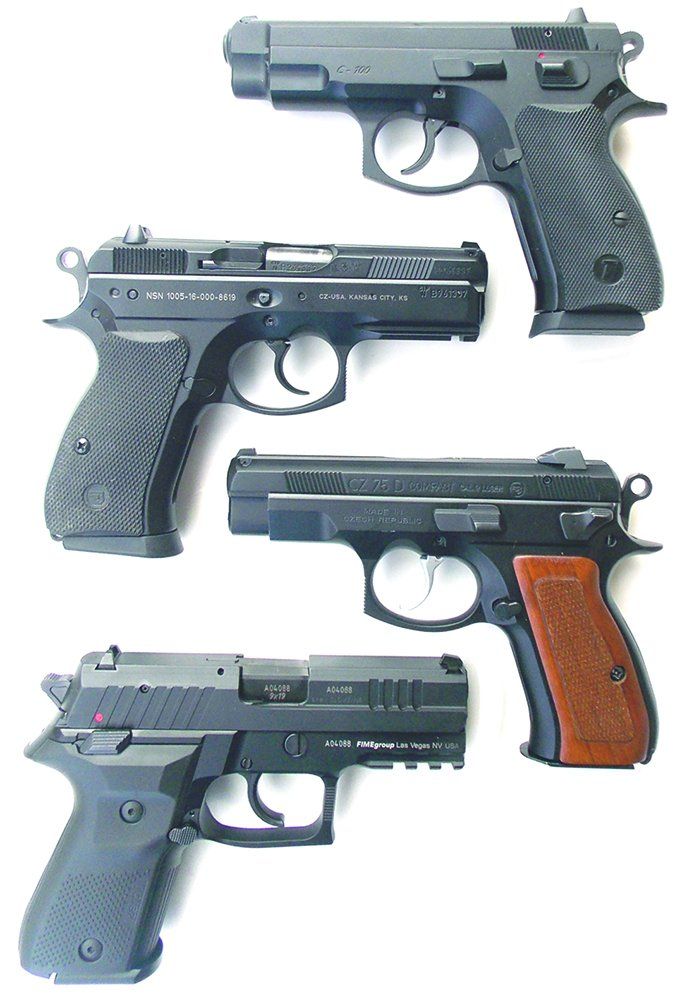
In this issue, we test four compact handguns chambered for the 9mm Luger cartridge, the most popular defensive cartridge, according to sales figures compiled by the Bureau of Alcohol, Tobacco, Firearms, and Explosives. The 9mm offers real power in a compact high-pressure cartridge. The handguns that chamber the cartridge are often very reliable, and modern loads have a lot going for them. A service-size pistol is too large for many people to carry concealed and are unwieldy in home-defense situations for others as well. As a result, the ideal 9mm handgun would seem to be a compact version of the service pistol. These are service handguns with a shorter grip and slide that makes the piece easier to carry and for many of us, easier to handle under pressure. But the short slide radius may make precision shooting more difficult.
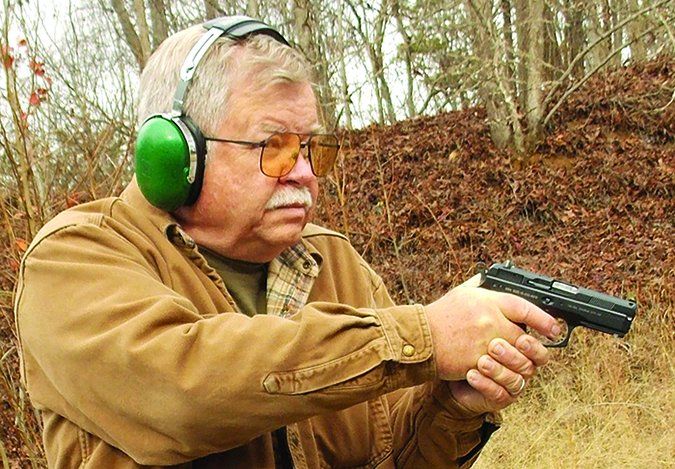
To see which compact pistol we preferred, we collected four examples of modern compact handguns:
1. The CZ-USA P-01, a double-action-first-shot pistol with a light rail and decocker.
2. The CZ-USA 75 D PCR Compact, which is more in tune with civilian needs than the police-type P-01.
3. The TriStar Canik C-100, an affordable clone of the CZ-USA 75 compact with the original selective-double-action-type CZ safety.
4. The Arex Rex Zero 1, a selective-double-action-with-decocker compact as a counterpoint to the CZs.
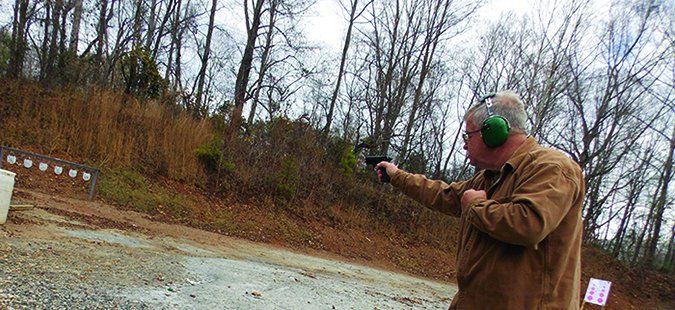
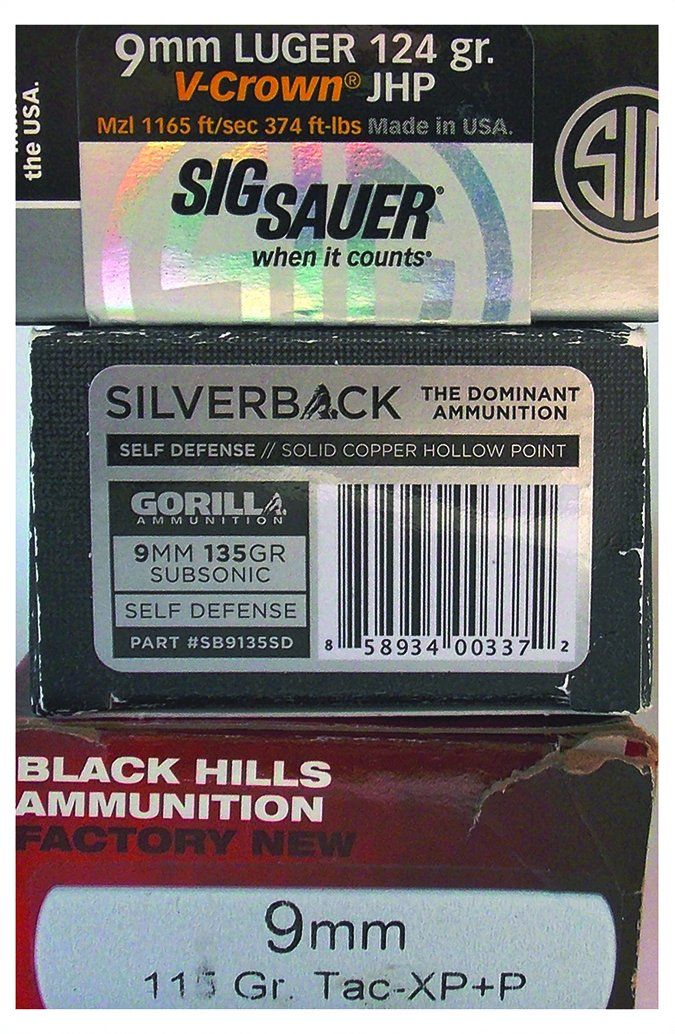
Some prefer a decocker on their double-action-first-shot handguns, but there is a smaller, but dedicated, group that prefers the selective-double-action type and others perhaps would like to have both. These shooters do not care for the Glock or a double-action-only system and often choose a CZ or SIG-type handgun. We fired off a variety of compact 9mm handguns and came to a conclusion, based on the opinion of our testers, as to which handgun is the best suited for most shooters, with the emphasis on the beginning, but still competent, shooter. Some of the choices are subjective, but the objective components — accuracy and reliability — are most important. If a compact 9mm fits your needs for self defense, one of these handguns will be a good choice, and one will be the best choice, we believe.
RANGE DATA
| Black Hills Ammunition 115-gr. TAC JHP +P | Canik 55 C-100 | CZ-USA 75D PCR Compact | CZ-USA P0-1 | Arex Rex Zero 1 |
| Average velocity | 1142 fps | 1185 fps | 1199 fps | 1163 fps |
| Muzzle energy | 332 ft.-lbs. | 358 ft.-lbs. | 367 ft.-lbs. | 345 ft.-lbs. |
| Smallest group | 3.25 in. | 2 in. | 1.8 in. | 1.65 in. |
| Largest group | 3.9 in. | 2.5 in. | 2.4 in. | 2.1 in. |
| Average group | 3.6 in. | 2.25 in. | 2.2 in. | 1.9 in. |
| SIG Elite 124-gr. V Crown | ||||
| Average velocity | 1172 fps | 1166 fps | 1179 fps | 1201 fps |
| Muzzle energy | 378 ft.-lbs. | 374 ft.-lbs. | 382 ft.-lbs. | 397 ft.-lbs. |
| Smallest group | 2.65 in. | 2 in. | 1.6 in. | 2 in. |
| Largest group | 3.5 in. | 2.6 in. | 2.6 in. | 2.9 in. |
| Average group | 2.75 in. | 2.2 in. | 2.1 in. | 2.4 in. |
| Gorilla Ammunition 135-gr. All Copper JHP | ||||
| Average velocity | 944 fps | 909 fps | 934 fps | 958 fps |
| Muzzle energy | 267 ft.-lbs. | 247 ft.-lbs. | 261 ft.-lbs. | 275 ft.-lbs. |
| Smallest group | 2.5 in. | 1.5 in. | 1.9 in. | 1.75 in. |
| Largest group | 3.6 in. | 2.25 in. | 2.5 in. | 2.6 in. |
| Average group | 3.2 in. | 1.9 in. | 2.3 in. | 2.2 in. |
| Notes: To collect accuracy data, we fired five-shot groups off a solid benchrest. Distance: 25 yards. We recorded velocity with a Competition Electronics Chrony Chronograph. The first sky screen was 10 feet from the muzzle. | ||||
| Ammunition notes: We purchased the Black Hills Ammunition 115-grain TAC JHP +P for $15.08/20 from MidwayUSA.com; the SIG Elite 124-grain V Crown for $14.01/20 and the Gorilla Ammunition 135-grain all-copper JHP for $30.49/20 from CheaperThanDirt.com. | ||||
TriStar Canik 55 C-100 9mm Luger, $365
GUN TESTS GRADE: C
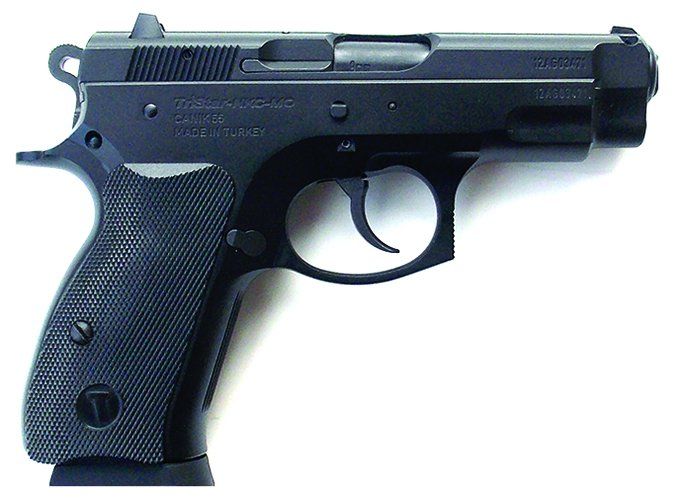
The C-100 is reliable, which is a good start. The simplicity of the design without highly developed sights or a light rail appeals to some. The price also appeals to many shooters. The problem was that the safety lever was so stiff as to be practically unusable. The double-action trigger was also heavy.
| ACTION | Semi-auto |
| OVERALL LENGTH | 7.2 in. |
| OVERALL HEIGHT | 5.03 in. |
| MAX WIDTH | 1.35 in. |
| WEIGHT UNLOADED | 26 oz. |
| WEIGHT LOADED | 33.5 oz. |
| BARREL LENGTH | 3.75 in. |
| BARREL | Steel |
| MAGAZINE | 14-rd. detachable box |
| SLIDE | Steel |
| FRAME | Aluminum |
| FRAME FRONT STRAP HEIGHT | 2.35 in. |
| FRAME BACK STRAP HEIGHT | 3.4 in. |
| GRIPS | Plastic |
| GRIP THICKNESS (max) | 1.4 in. |
| GRIP CIRCUMFERENCE (max) | 5.4 in. |
| SIGHTS | Fixed |
| TRIGGER PULL WEIGHT (SA) | 5.9 lbs. |
| TRIGGER SPAN (SA) | 2.55 in. |
| SAFETY | None |
| WARRANTY | 1-year repair, 4-year parts |
| TELEPHONE | (816) 421-1400 |
| WEBSITE | TristarArms.com |
| MADE IN | Turkey |
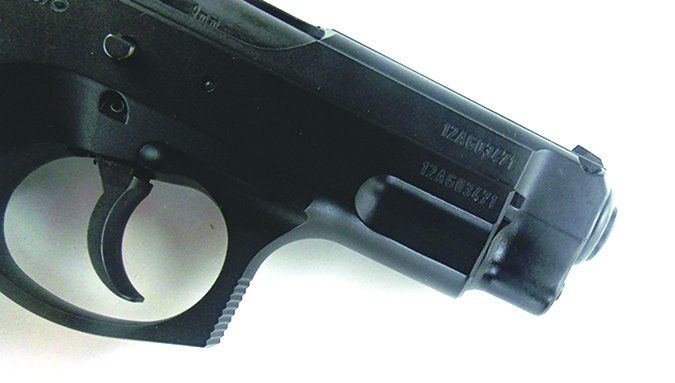
This is a recent price for this handgun at BudsGunShop.com. TriStar is the importer, while Canik 55 is the Turkish manufacturer, and C-100 is the model designation of this compact 9mm handgun. The C-100 is a compact CZ 75-type handgun with a steel slide and aluminum frame. The action is the original CZ 75-type with a double-action-first-shot trigger. A manual safety allows the handgun to be placed on Safe with the hammer cocked. There have been some changes in the lockwork, and this handgun may be placed on Safe with the hammer down, which isn’t possible with the original and current CZ 75 configuration. The change makes for a more versatile handgun, particularly for home ready. We like the idea of a handgun on Safe, yet that is still ready, more so than one that is ready without a manual safety. This is one of two handguns tested with a manual safety.
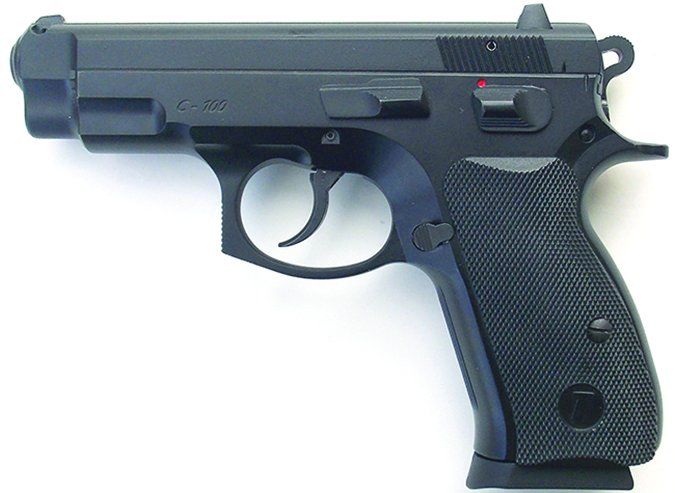
The finish of the C-100 is a nicely applied deep black. The grip panels are hard plastic. The C-100 incorporates a positive firing-pin block in the design. The firing-pin block is similar in operation to the CZ 75 B but differs in appearance. The geometry of the grip frame differs subtly from the CZ 75 but not enough to affect firing. However, grip panels for the CZ 75 will not fit the C-100, so beware when ordering custom grips. The sights are credible combat sights comparable to the CZ 75 and REX Zero. The rear sight rides in a dovetail and may be drifted for windage adjustment. The front sight is pinned in place in typical CZ fashion. A slight ribbing texture is added to the top of the slide. There are serrated portions in tandem on each side of the raised rib.
The pistol features a dual wound recoil spring. This particular C-100 was very tight and required more effort than the other handguns to disassemble, although it loosened slightly after firing. When dealing with European-made firearms, it is a good plan to thoroughly degrease the piece before firing. The slide runs inside the frame in CZ fashion. This allows for a lower bore axis and less muzzle flip. There were tool marks evident on both slide flats when the C-100 was field stripped. We noted these tool marks and decided to check the CZ 75 pistols for similar marks. CZ pistols are usually more difficult to rack because of the lower bore axis (which can be harder to grip) and the way the slide rides in the frame. The C-100’s cocking serrations are adequate for the type, we felt.
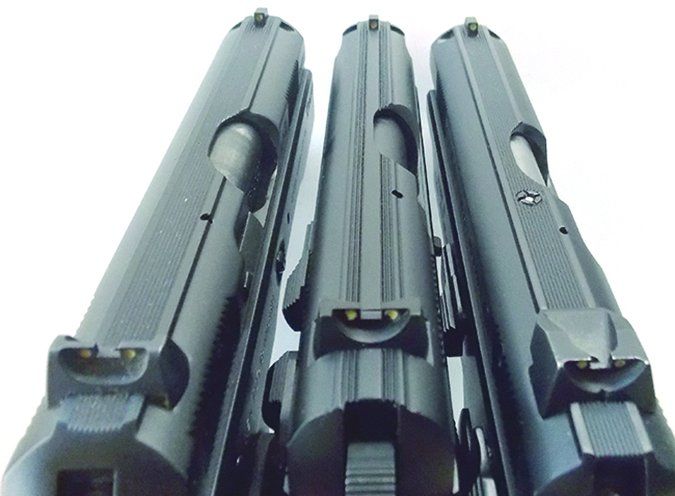
The pistol is supplied with two 14-round magazines. CZ 75 magazines readily interchange. These magazines feature bumper pads that allow the magazine to absorb more punishment when dropped. We recently conducted a magazine test in which we cracked a CZ 75 baseplate, but it kept going. The bumper pads add a little length but are worthwhile. The bumper-pad magazines are easier to quickly slap home, but they protrude slightly from the magazine well. The magazines were well made with a good finish. The front strap was serrated for adhesion. The front of the trigger guard was serrated for good purchase, but none of the testers use this type of forward finger grip. We tried it a few times and found the serration worked okay, but we went back to our regular shooting style during the test.
The overall fit and finish of the pistol were credible. The safety, however, was stiff. It was practically impossible for the average shooter to move the lever into the Safe or Fire position when the pistol is in the firing grip. Our female tester had a difficult time handling the pistol. The safety, once pressed into the on-safe position, was very stiff to return to the Fire position. Our male raters had to place the safety in the Fire position on the way up to the firing position and could not depress the safety lever when the handgun was in the firing position. Our female tester had a difficult time and had to resort to two hands to place the lever in the Safe position. We have tested the T-100 from the same maker with the same design except for a different dust cover, and the problem was not evident. The advantages of the CZ 75 system include moving the safety to the Safe position during movement and thus retaining the single-action trigger press at the next firing position. This heavy safety abrogates many of the advantages of the pistol. We rated the C-100 down a full grade based on this problem. It isn’t simply a heavier-than-usual amount of force needed to operate the safety. The safety on this pistol was practically unusable.
Also, the double-action trigger was heavy at about 16 pounds. While this is an economy pistol, the heavy trigger limits the C-100’s utility for fast defense work. One tester fired the pistol and noted that if issued this handgun or anything with a similar DA trigger, he would have to cock the hammer before firing and use the single-action option to have any hope of connecting. Those with double-action-first-shot pistol experience rated the trigger as heavy as anything they could recall. The single-action trigger was good at just under 6 pounds.
The C-100 was fired with four loads that were also used in the other three handguns. These included a full-metal-jacket practice load, two different weight personal defense loads, and a +P load. The FMJ handloaded ammunition was used only in the combat evaluation. We used the Hornady 115-grain FMJ bullet (100-200-080WB, $59/500 from Brownells.com) over WW 231 powder loaded to 1100 fps average for the combat evaluation. Our accuracy and chronograph ammunition included the Black Hills Ammunition 115-grain TAC +P, SIG Elite 124-grain V Crown, and the Gorilla Ammunition 135-grain all-copper JHP. The C-100 and the other pistols were fired with 45 rounds of the practice load at 5, 7, and 10 yards, 15 rounds at each station, and a final test with 10 rounds of the +P load as a measure of control at 10 yards. There were no malfunctions of any type related to the C-100. One tester allowed his thumb to hit the slide lock during recoil and tie the gun up. This isn’t the first time we have seen this with the CZ-type compact. This was his first trial, and he did not repeat the misstep with the other handguns. The C-100 was comfortable to fire. Combat-firing results were limited by the heavy trigger, even at 5 yards. We fired double action first shot at 5 yards and cocked the hammer at 10 and 15 yards. There was a definite sponginess in the trigger action not present in the CZ pistols. The pistol was controllable even with the +P loading. Groups were good in the single-action mode, and the pistol’s sights were well regulated for 115-grain loads.
Moving to benchrest accuracy testing, we fired five-shot groups with the three defense loads. The C-100 is accurate as compact 9mm handguns are rated, but here it was the least accurate of the four pistols. We were able to control the spongy trigger off the bench rest with a bit of effort. The pistol delivered a single 2.5-inch group at 25 yards with the Gorilla all-copper 135-grain JHP, one of the few sub 3-inch groups with this pistol, but overall we found the C-100 gave an adequate accuracy showing for a 3.7-inch-barrel compact. The pistol is clearly accurate enough for personal defense. Still, we preferred the more accurate handguns.
Our Team Said: The C-100 exhibited faultless reliability, the baseline for a personal-defense handgun. We like the bumper pad magazines. The finish is good, despite quite a few internal tool marks. There is a good reserve of ammunition. We rated the piece down a full grade due to the difficulty with the safety lever and another grade down for the heavy double-action trigger. When these problems are considered, we don’t gauge the C-100 to be a good buy, but it is a reliable defense handgun.
CZ-USA 75D Compact 91194 9mm Luger, $546
GUN TESTS GRADE: A
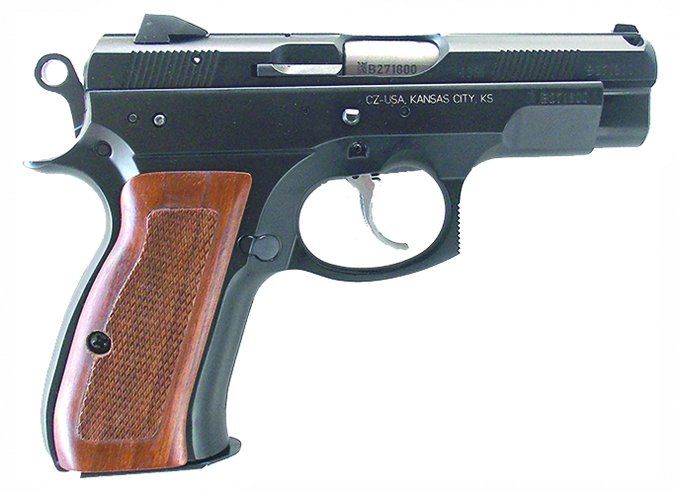
The 75D is a clean design that we enjoyed firing. We like everything about the 75D except the absence of a light rail. With snag-free sights and a loaded-chamber indicator, the 75D is a superior concealed-carry handgun.
| ACTION | Semi-auto, DA/SA |
| OVERALL LENGTH | 7.2 in. |
| OVERALL HEIGHT | 5 in. |
| MAX WIDTH | 1.4 in. |
| WEIGHT UNLOADED | 28 oz. |
| WEIGHT LOADED | 35 oz. |
| BARREL LENGTH | 3.75 in. |
| BARREL | Steel |
| MAGAZINE | 14-rd. detachable box, double stack |
| SLIDE | Steel |
| FRAME | Aluminum |
| FRAME FRONT STRAP HEIGHT | 2.35 in. |
| FRAME BACK STRAP HEIGHT | 3.4 in. |
| GRIPS | Rubber |
| GRIP THICKNESS (max) | 1.4 in. |
| GRIP CIRCUMFERENCE (max) | 5.4 in. |
| SIGHTS | Fixed |
| TRIGGER PULL WEIGHT (SA) | 5.5 lbs. |
| TRIGGER SPAN (SA) | 2.75 in. |
| SAFETY | Stop on hammer; firing pin block |
| WARRANTY | 5-year limited |
| TELEPHONE | (800) 955-4486 |
| WEBSITE | CZ-USA.com |
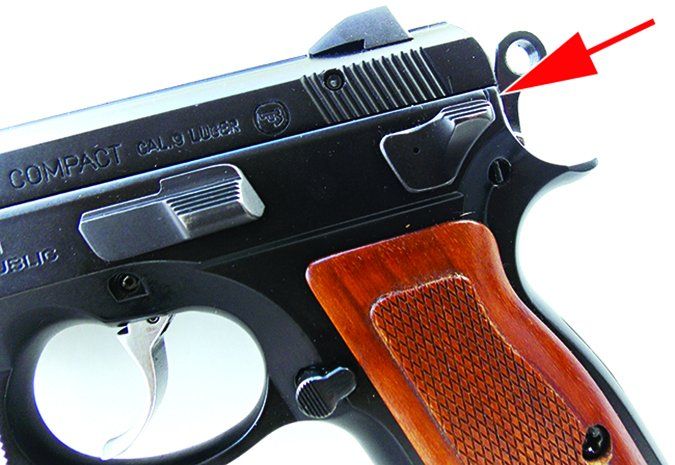
This was a recent price from ImpactGuns.com. The CZ-USA 75D is perhaps the least-known CZ-type 9mm, and this was our CZ fan’s first experience with the type. The pistol is very similar to the C-100 and P-01 pistols. The dust cover treatment is different from the C-100, although neither has an attachment point for a light rail. The dust cover of the C-100 is convex, while the CZ-USA 75D is flat on each side. The trigger guard and front strap stippling are the same as the C-100 and P-01. The primary difference in appearance compared to the C-100 is that the 75D has forward cocking serrations. We like this a lot in a handgun that sometimes requires more force to rack the slide. The trigger guard stippling of the CZ-USA pistols is perhaps a bit sharper than the C-100, but there is not a practical difference. The 75D features a decocker on the left rear of the frame that safely lowers the hammer from the full-cock position. This is a more popular set up, if measured by popular demand. While we were chastised by a reader for stating this after a previous match up, the fact is, institutional users, and the public as well, strongly prefer the decocker and vote with their dollars. There is no manual safety. There is also a unique loaded-chamber indicator.
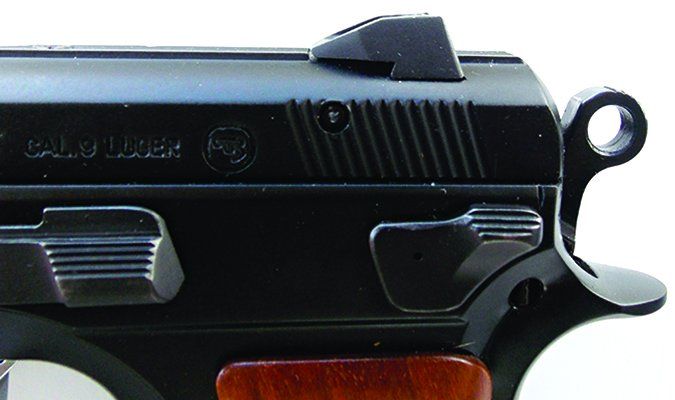
The finish is slightly different than that found on the C-100. We cannot comment on long-term finish durability, but the 75D’s finish was well done. The sights of the 75D are a slanted rear type intended to provide a nonsnag profile as the pistol is drawn. The owner added a set of Hogue wooden grips ($85 from HogueInc.com) that we found attractive and nicely checkered. The CZ-USA 75D is supplied with rubber grips. The composition of the original rubber grips is softer than on the C-100, we felt, and likewise offers better adhesion. The Hogue grips’ benefit was primarily aesthetic compared to the CZ-USA P-01.
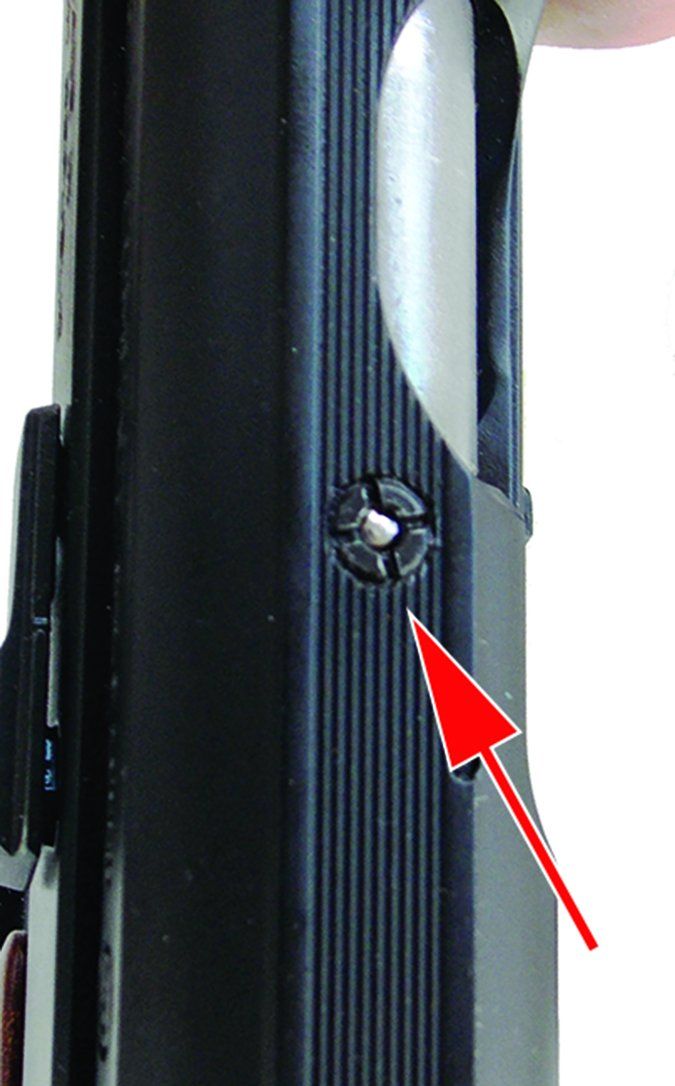
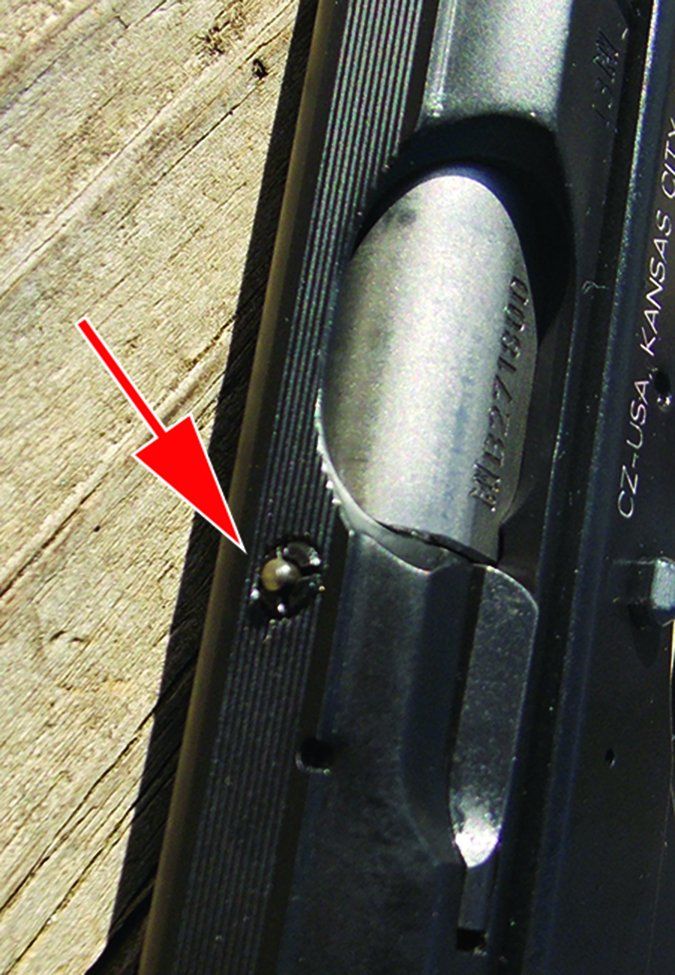
The CZ-USA 75D was supplied with flush-fit magazines. The sights of the 75D did not seem to offer an advantage in accuracy, but we like them the best of the four pistols due to the snag-free design. We like the rib between the sights. We field-stripped the 75D and examined the internals. Tool marks were evident, but not to the extent of those in the C-100, but they are certainly there, and the dust cover isn’t well finished internally, we thought. The pistol wasn’t as tight to field-strip as the C-100. The double-action trigger is much smoother than the C-100 at 12 pounds. The single-action trigger breaks at a smooth 5.5 pounds. The face of the trigger is serrated, which we felt helped in controlling the trigger for best accuracy. Firing tests were conducted with the same loads used with the other three handguns. The smooth double-action trigger was useful to 15 yards, and the pistol gave better results on the firing range than the C-100, as the range data show. There were no failures to fire or function of any type. From the bench, the best group was a solid 1.5 inches with the Gorilla Ammunition 135-grain JHP, an all-copper hollowpoint. The average was good with all loads.
Our Team Said: There were no demerits for the CZ-USA 75D. It delivered excellent results. However, if you want to mount a light on the gun, you’ll need the P-01.
CZ-USA 75 P-01 91199 9mm Luger, $576
GUN TESTS GRADE: A (Best Buy)
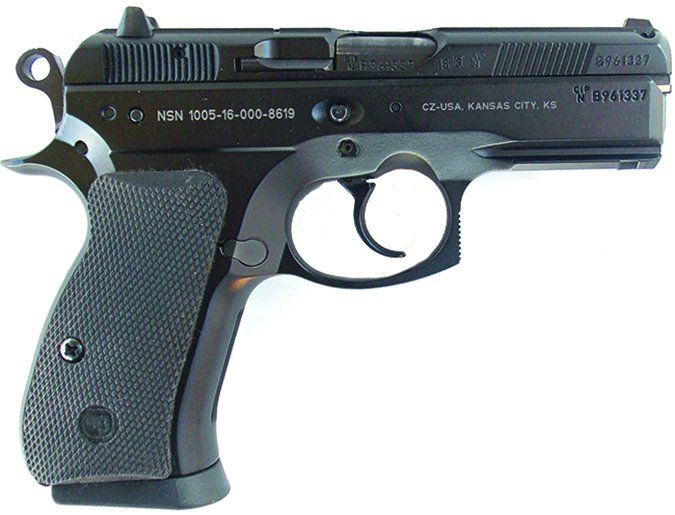
The P-01 offers good quality, faultless reliability, smooth operation and a good trigger action. Accuracy is good. The sights are adequate and the pistol features a light rail that two of the four pistols tested do not. We would buy the P-01.
| ACTION | Semi-auto w/ decocker, DA/SA |
| OVERALL LENGTH | 7.2 in. |
| OVERALL HEIGHT | 5 in. |
| MAX WIDTH | 1.35 in. |
| WEIGHT UNLOADED | 28 oz. |
| WEIGHT LOADED | 35 oz. |
| BARREL LENGTH | 3.75 in. |
| BARREL | Steel |
| MAGAZINE | 14-rd. detachable box |
| SLIDE | Steel |
| FRAME | Aluminum |
| FRAME FRONT STRAP HEIGHT | 2.35 in. |
| FRAME BACK STRAP HEIGHT | 3.4 in. |
| GRIPS | Rubber |
| GRIP THICKNESS (max) | 1.4 in. |
| GRIP CIRCUMFERENCE (max) | 5.4 in. |
| SIGHTS | Fixed |
| TRIGGER PULL WEIGHT (SA) | 5.5 lbs. |
| TRIGGER SPAN (SA) | 2.75 in. |
| SAFETY | None |
| WARRANTY | 5-year limited |
| TELEPHONE | (800) 955-4486 |
| WEBSITE | CZ-USA.com |
| MADE IN | Czech Republic |
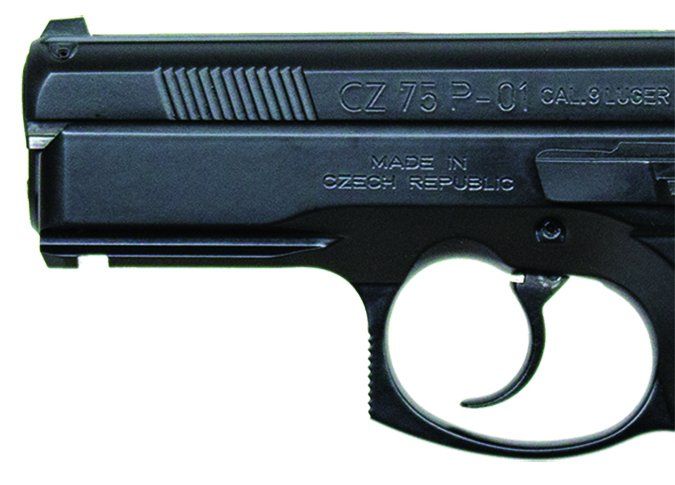
This was a recent price offered by ImpactGuns.com. We found it interesting that the P-01 cost an average of $31 more than the very similar 75D. Yet the 75D features a loaded-chamber indicator and improved snag-free sights not found on the P-01. In contrast, the P-01 features a monolithic dust cover with a light rail mount. And there is the difference — if you wish to mount a light on your combat gun, the C-100 and 75D cannot accommodate you. The Rex likewise features a light rail.
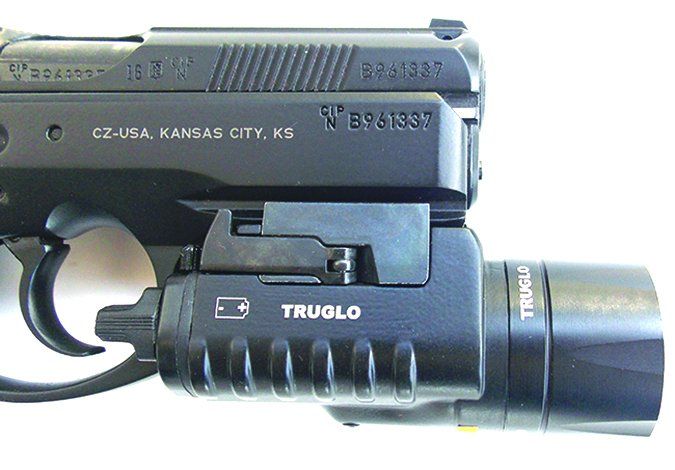
As far as sights go, none of the four pistols has an advantage in sight-picture quality, but the slanted snag-free sight of the 75D would be our pick as the best. In common with the 75D, the P-01’s frame-mounted decocker was easy to use well and was positive in operation. When the decocker is used, the hammer falls to a type of half-cock position. The DA trigger is slightly faster in this mode. We advise against manually lowering the hammer with any handgun that uses a decocker. There is a possibility of short-circuiting the drop safety, and the firing-pin block may not lock in place if you manually lower the hammer. One of the 1911 shooters rested his thumb on the decocker during the firing test and found the rest comfortable enough to keep the digit in place as if it were on the safety lever of the 1911. Fit and finish were good; however, like the other 75D, the P-01 has more tool marks internally than the Rex.
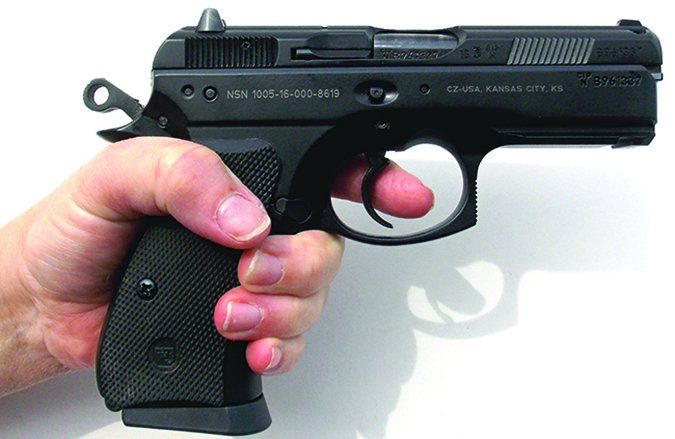
We found the trigger action to be the smoothest of the four DA triggers, and its smooth-faced trigger gave good control in double-action fire. The double-action trigger breaks at about 11 pounds, while the single-action trigger felt crisp at 5.25 pounds. This is perhaps the luck of the draw because the action parts are likely produced on the same assembly line as the 75D Compact, but then perhaps the P-01 is smoother by design. It is much more popular and well known. The P-01 pistol is much smoother than the C-100, we believe, but not so much smoother than the 75D where that would be an overwhelming consideration.
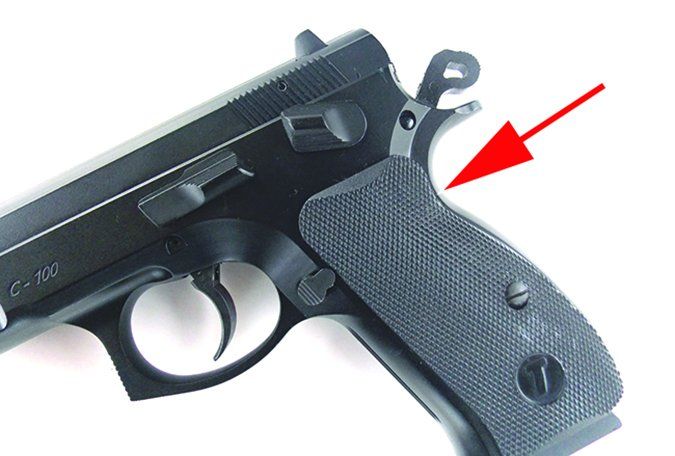
On the firing range, the P-01 gave good results. Combat groups with both the handloads and the +P loading were what we like. The grips gave good adhesion when firing, and the pistol was controllable. From the bench, the pistol gave a good showing, with the best group of 1.6 inches coming with the SIG Sauer 124-grain JHP. This was the best showing of the test.
Our Team Said: Among the pistols tested, the P-01 gave the best results in combat firing and in accuracy. Some of the groups fired were half the size of the groups fired with the C-100 handgun. Considering this performance and the ability to mount a light rail, we rate the CZ-USA P-01 as a Best Buy.
Arex Rex Zero 1 CP 9mm Luger, $603
GUN TESTS GRADE: B
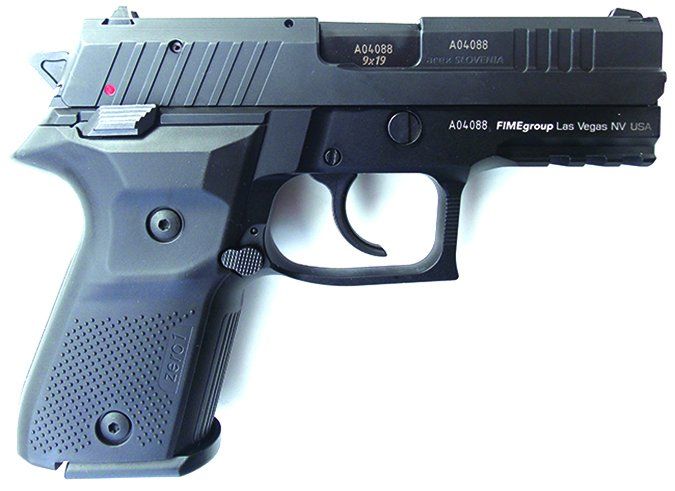
The Rex is a new pistol with no flies on it. It performed well during the combat test and turned in credible accuracy. Reliability was faultless. We liked the decocker/slide-lever combination and the functioning ambidextrous safety.
| ACTION | Semi-auto |
| OVERALL LENGTH | 7.3 in. |
| OVERALL HEIGHT | 5.3 in. |
| MAX WIDTH | 1.3 in. |
| WEIGHT UNLOADED | 28 oz. |
| WEIGHT LOADED | 35 oz. |
| BARREL LENGTH | 3.9 in. |
| BARREL | Steel |
| MAGAZINE | 15-rd. detachable box |
| SLIDE | Steel |
| FRAME | Steel |
| FRAME FRONT STRAP HEIGHT | 2.2 in. |
| FRAME BACK STRAP HEIGHT | 3.45 in. |
| GRIPS | Plastic |
| GRIP THICKNESS (max) | 1.4 in. |
| GRIP CIRCUMFERENCE (max) | 5.9 in. |
| SIGHTS | Fixed |
| TRIGGER PULL WEIGHT (SA) | 5.4 lbs. |
| TRIGGER SPAN (SA) | 2.6 in. |
| SAFETY | Manual |
| WARRANTY | 1-year limited |
| TELEPHONE | (702) 215-3600 |
| WEBSITE | Fimegroup.com |
| MADE IN | Slovenia |
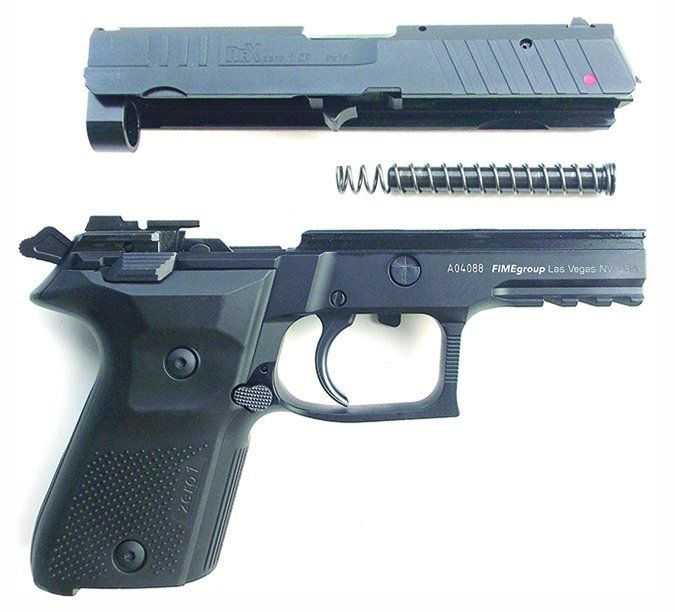
This was a recent price posted on CheaperThanDirt.com. The Rex compact is both the newest and the most expensive of the pistols tested. The Rex isn’t an exact clone of the SIG P series as the C-100 pistol is a clone of the early-model CZ 75 compact. The resemblance of the Rex to the SIG is evident, particularly in the engineering and design detail, and that is part of the appeal of the pistol. The Rex has many similarities to the SIG. The company simply took proven design principles and addressed the few shortcomings of the SIG P series. At Gun Tests, each handgun must stand or fall on its own merits. But given the design of the Rex, anyone who has handled the SIG P series will be able to load, make ready, and fire the Rex with little acclimation. The pistol exhibits good-to-excellent fit and finish. The slide is well machined with attention to detail. The slide flats are well finished.
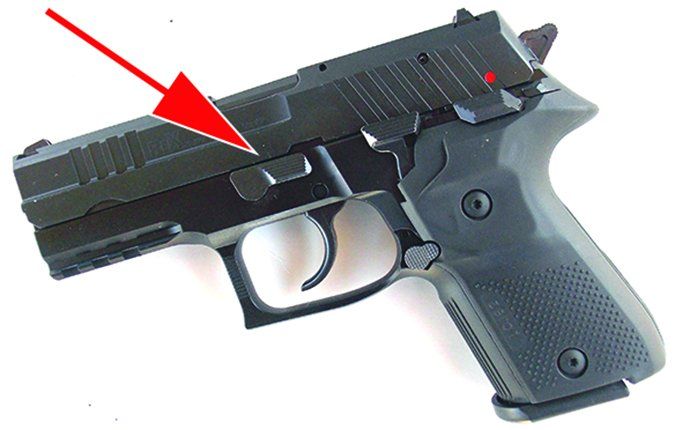
The sights ride in dovetail slots in the slide. The sights are drilled for the popular white 3-dot inserts. These sights were good, but there was no advantage over the other pistols. This handgun locks up by butting the barrel hood into the dust cover. The lockup is tight. The slide features forward cocking serrations. It was noticeably easier to rack the slide of the Rex than the CZ-USA pistols, SOP for the SIG versus the CZ slide design. The pistol features a positive firing-pin block. The squared-off trigger guard is nicely serrated. There is a cut-out below the trigger guard that allows a little lowering of the bore axis. The CZ accomplishes a lower bore line above the hand by running the slide inside the frame rail. The Rex does not feature as low a bore axis, but the Rex makes a good try. The stippled front strap affords the shooter good adhesion. The Rex features a light rail for mounting combat lights or laser sights. The rear grip strap is flatter than the S-shaped CZ. We believe the designer was attempting to make trigger reach easier with this fat-gripped pistol. Two indentations in the grip panels, one on each side, also lessen the trigger reach to an acceptable measurement. Still, we felt the CZ-USA 75 pistols were more comfortable in the hand. The plastic grips are pebbled and offer good adhesion when firing. Coupled with the flat backstrap and reduced trigger reach, the pistol is tolerable for double-action use. The magazines are well finished with good polish and positive function. A single magazine notch locks the magazine in place. The significant difference between the Rex, the SIG pistol it is modeled after, and the CZ-USA pistols are in the slide lock, decocker, and manual safety. With the 75-type pistols, you may have either the manual safety or a decocker and not both. The SIG features a decocker, and on most models no manual safety. There has also been a tendency one of our raters has noted in extensive training classes as an instructor that some shooters ride the slide lock of the SIG with the thumb during firing and do not allow the slide to lock back on the last shot. The Rex addresses many concerns with the new system. It is not complicated and works as designed.
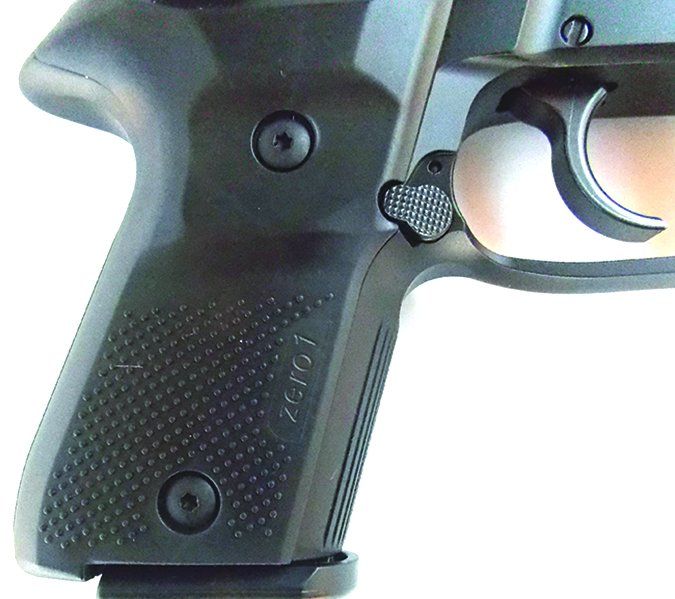
The Rex combines the SIG-type decocker and slide lock into a single lever. The manual of arms is as follows: Lock the slide to the rear, insert a loaded magazine, and press the combination slide lock and decocker lever to release the slide. The slide runs forward, loading the chamber. Release pressure on the lever, press it again, and you will safely lower the hammer without the need to manually lower the hammer. We executed this drill several times with speed reloads. The system works well. After dropping the slide, no matter if we kept the pressure on the lever or pressed down hard during the operation, the lever did not drop the hammer unless we consciously released pressure on the lever and pressed it again. You will not inadvertently drop the hammer as you release the slide lock to drop the slide. We like this a lot. The SIG pistol has few drawbacks, but one of them is that the location of the slide lock seems to invite shooters to ride their thumb on the slide lock during firing. This results in the failure to lock the slide open on the last shot as the thumb is riding the slide lock.
Even those who have mastered the SIG and avoided this pitfall will find the Rex decocker/slide lock handy and superior. In the location normally occupied by the slide lock of the SIG is a manual safety. This frame-mounted safety is unobtrusive but positive in operation. This safety may be manipulated easily by the thumb. The pistol may be carried on safe with the hammer down or the hammer cocked. We like this safety and the location and easy operation.
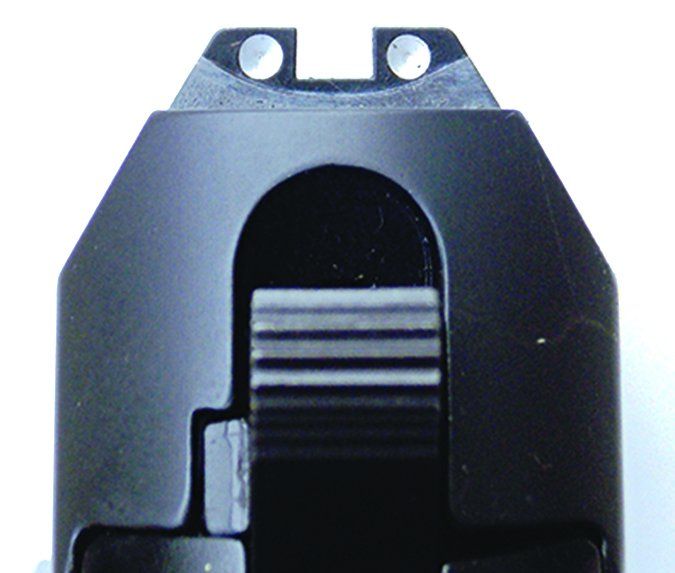
When field-stripping the Rex, we noted that the interior finish and polish was the best of the four handguns tested. There were no discernible tool marks, and the finish was good throughout the interior of the Rex. The Rex was fired on the same course as the other handguns. The pistol is comfortable to fire, with modest recoil and muzzle flip.
The greatest drawback of the pistol is the double-action first-shot trigger press. This trigger was estimated at a heavy 16 pounds. There was a well-defined hard spot midway in the trigger’s travel. This trigger is as heavy as the C-100, but leverage is slightly better on the Rex. It is also heavy, but smoother than the C-100. The single-action trigger press is likewise smooth and much lighter at 5.5 pounds. The single-action trigger has the typical long SIG-type reset. The pistol is controllable in firing the heaviest loads. It is actually very comfortable to fire, with good balance. In combat firing, the pistol was more accurate than the C-100 and equaled the CZ-USA pistols overall.
Downside: We found the girth of the grip too large to use the magazine release efficiently with the firing hand thumb. However, the magazine release is ambidextrous, so we used the firing-hand forefinger to release the magazine. This worked well in rapidly reloading the pistol. In firing for benchrest accuracy, the solid lockup, good sights, and decent single-action trigger were noted.
Our Team Said: The Rex showed excellent accuracy, with some groups as small as 1.65 inches. We find the Rex to be an excellent answer to some of the problems of manipulating a first-shot double-action pistol with the manual safety. You may use or ignore the safety as you prefer.
Written and photographed by R.K. Campbell, using evaluations from Gun Tests team testers.






























